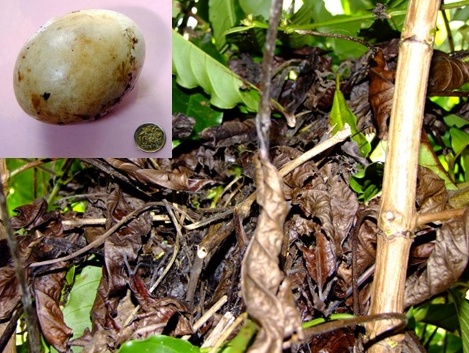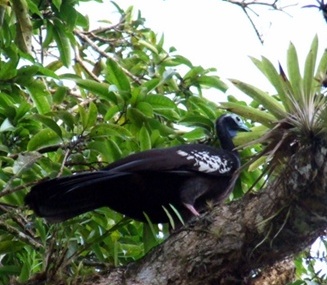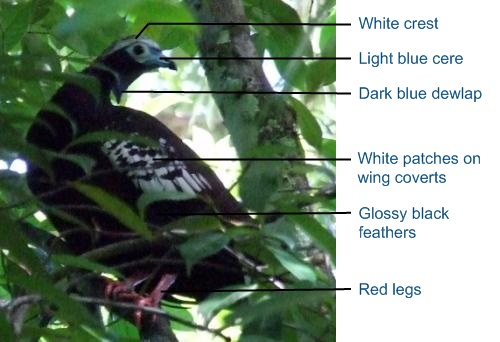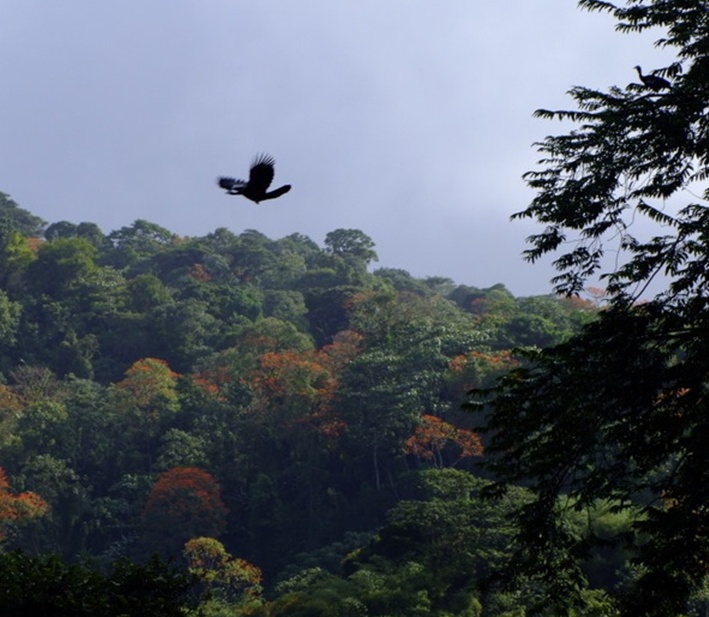What we know about Pawi
(Names Appearance Sounds Parenting Nests Eggs Chicks Habitat Threats Conservation)
The Pawi by any other name... Locally the Pawi is sometimes called the Wild Turkey. Internationally it is known as the Trinidad Piping-guan or by its scientific Latin name Pipile pipile. Years ago, when it was thought to be the same species as the Common Piping-guan of South America, it was called Pipile aburia instead of Pipile pipile but that name is no longer used to refer to our Pawi, although you may see it referred to by this name in older documents. 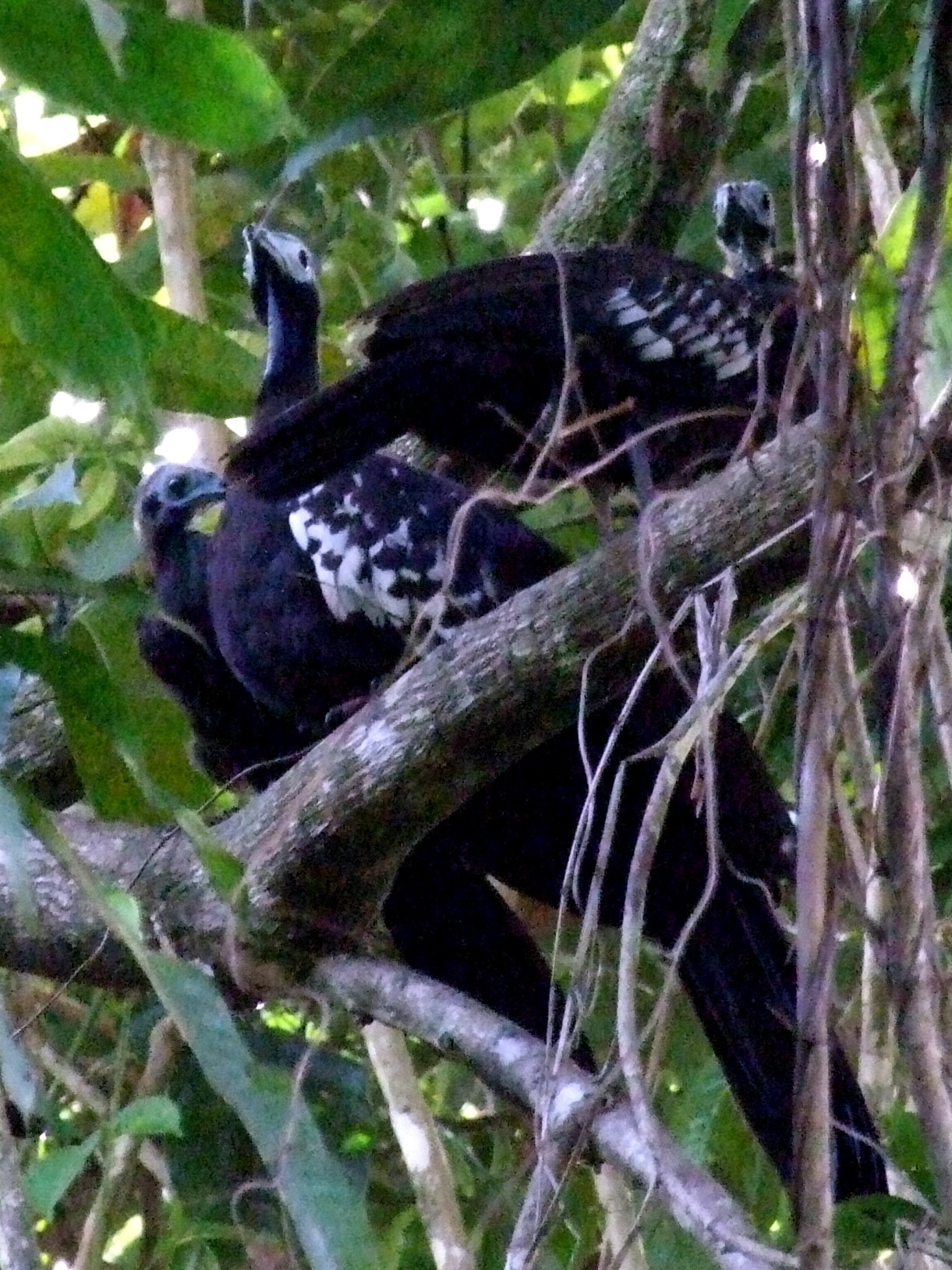 An adult and two juveniles (photographer Kerrie Naranjit)
Pawi Sounds Pawi use several sounds to communicate with each other. Most of these are vocalizations but they can also choose to produce a sound with their wings in flight called "wing drumming" which sounds very similar to the sound of a motorcycle but not as loud. It is thought that the wing drumming is associated with the mating season and may be done by the male. Several distinct vocalizations have been recorded for the Pawi. The one most frequently heard is its "long piping" call from which the bird got its formal name (Trinidad Piping-guan). This call consists of four ascending whistles which are repeated at intervals. The others are "short piping" (a single-note whistle), a "pee-you" call, a "pew", and a "quack" or "quack-squeak" call. There are also other vocalizations used exclusively between parents and chicks. We do not yet understand the meaning of the different vocalizations but current research will lead to a better understanding of the part they play in Pawi communication.
Pawi egg (slightly dirty) and nest Where do Pawi Live? (Pawi Habitat) Once abundant throughout Trinidad’s forests from the mountain peaks down to sea level, Pawi are now predominantly restricted to the forests on eastern side of the Northern Range (although there have recently been unconfirmed reports of Pawi in the South). Traditionally, Pawi have preferred primary forest where they spend most of their time in the canopy. During the cooler parts of the day they can be found in the high tree tops feeding and preening but they retreat to the cooler under-canopy as the day gets hotter. Over the years, in some areas, Pawi have become accustomed to living in more disturbed areas such as agricultural land, gardens, estates and near clearings and roadways and can now reliably be found in such areas. This adaptability to a changing habitat may be one the reasons they are still with us.
Pawi drinking from an epiphyte (Photographer: Kerrie Naranjit) Threats Pawi were plentiful in the past, living in groups in the forests across Trinidad but now scientists estimate that there are less than 200
individuals on the planet making the species in danger of extinction. Why this decrease in population size and range? The two main reasons are illegal hunting of the bird and habitat damage and destruction. Pawi Hunting Historically, hunting contributed greatly to the decline of the Pawi population. Their size and unruffled nature made them easy targets for hunters and many were killed over the years reducing the population dramatically. Although the birds are now protected by law, illegal hunting of Pawi still occurs today. In some areas it has been made almost non-existent as a result of increased awareness and growing community lead, Pawi-focused eco-tourism which make Pawi more valuable alive than dead. Unfortunately this is not true for all areas and more enforcement, awareness and community involvement needs to occur to create a safer environment for these birds. Habitat Destruction Habitat disturbance and destruction is a less direct threat but is still of great concern.
Logging, clearing of the forest vegetation and pollution all play a role in the disturbance
and/or destruction of the Pawi’s forest habitat. These activities destroy areas that it may use
for roosting, nesting and feeding. It may also be possible that chicks can be killed during
vegetation clearing or slash and burn activities. To protect these birds we need to ensure that
there is enough suitable forest to allow their survival. As stated above, in some areas the Pawi can be seen
in and around disturbed habitats such as roads and clearings for housing
and agriculture but it is highly unlikely that this is the best living environment for them . While they do survive in these areas they could not do so without the nearby forest. The recent creation of the Matura National Park
as an Environmentally Sensitive Area can go a long way in the protection of some of the Pawi’s natural
habitat but we must also ensure that our activities in the forest are regulated and not allowed to
promote destruction or disturbance of this bird and its habitat. |
Adult Pawi (Photographer: Kerrie Naranjit) What do Pawi look like? An adult Pawi is a large, glossy black, turkey-like bird with white on the wing coverts, a
white crest, red legs, a blue cere and darker blue dewlap. Both male and female Pawi have the same colouration and do not appear to differ visually but there is the possibility that there is a slight difference in size with the male being larger than the female as is seen in closely related species. There has also been the suggestion that there is a difference between the dewlap size of males and females. A juvenile Pawi is similar in appearance to the adult but with a dark patch behind the ear, a smaller, greyer dewlap and paler red legs (see photo on left). The white patches on the wing coverts are also much smaller and increase as the bird reaches adulthood. Pawi chicks, like chicken chicks, are precocial which means that they hatch covered in downy feathers and are able to move about soon after hatching. The chicks have dark feathers and have been reported to have pale red legs and a blue cere.
Pawi vocalizing (photographer: Kerrie Naranjit) Family Life (Reproduction) The Pawi has a lengthy breeding season and is believed to be monogamous during this season. That is, a mated pair will stay together at least for that season. The male attracts the female with a courtship dance in the canopy, involving quack and quack-squeak vocalizations. Mating has been observed to occur on the ground. The Pawi build shallow platform-shaped nests of twigs and vines, sometimes weaving in branches still attached to the nesting tree. The only confirmed nest was seen in a coffee tree about 2.5m off the ground but there have been reports of nests being built on the ground or in low tangles of vines. Pawi are expected to lay 2-3 cream coloured eggs which hatch within 28-32 days. The chicks are born precocial (with feathers and almost fully mobile) and leave the nest on hatching day. Both parents are known to care for the young, feeding and protecting them until they have attained adult size.
An example of Pawi habitat. Can you see 2 Pawi? (Photographer: Kerrie Naranjit) Food and Water Adult Pawi are probably exclusively vegetarians but, as growing chicks, insects and other small invertebrates may have be a large part of their diet. Pawi are known to eat the fruits, seeds, leaves and flowers of many native and introduced plants including the fruit of nutmeg, cajuca (wild nutmeg) and matchwood; cocoa and fiddlewood flowers and black sage leaves. As primarily arboreal (tree dwelling) birds they prefer to drink water from epiphytes up in the canopy but do come down to rivers and forest pools to drink if water is not available in the trees (usually in harsh dry seasons). |
